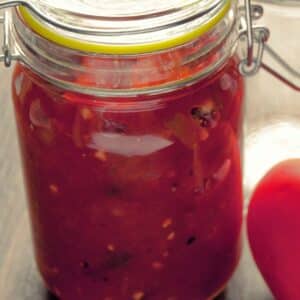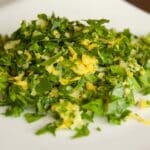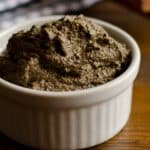For food enthusiasts and health-conscious cooks, there's a culinary alchemy that's gaining steady popularity — the transformation of regular salsas into a vibrant, nutrient-packed powerhouse through a process called lacto-fermentation. This method adds a tangy depth to the familiar flavors and kick of traditional salsas, while enhancing their nutritional profile.

Jump to:
Lacto-Fermented Salsa
At a glance, lacto-fermentation might sound like a technical term from a scientific journal, but it's simpler than it appears. This traditional method of preserving food not only increases its shelf life but also imbues it with an array of health benefits. The term 'lacto' refers to lactic acid bacteria, the good kind of bacteria that's crucial to the process, and is not about dairy-based fermentation.
Making your own lacto-fermented salsa at home opens up a world of customization and creativity. There's truly no limit to the flavors you can infuse, and the satisfaction of producing your own healthy condiment is unmatched.
Lacto-fermented salsa isn't just a condiment; it's a versatile ingredient that can elevate countless meals. Stir it into your morning Scrambled Eggs with Salmon, blend it into a Creamy Avocado Dressing on Steak, or use it to top your favorite Burrito Bowl for an instant flavor and health boost.
Ingredients
Serves: 128 Prep Time: 40 minutes Ferment Time: 3-5 days
- 12 cups fresh tomatoes, chopped
- 2 cups chilies, seeded and chopped (Jalapeños and Serranos are good choices)
- ¼ cup dried oregano
- 2 tablespoon cumin
- 8 garlic cloves, chopped
- 2 onions, chopped
- ¼ cup sea salt
How to Make Lacto-Fermented Salsa
Wear rubber gloves to handle the chilies and combine the chopped tomatoes, chilies, oregano, cumin, garlic and onions together.
Place the tomato mixture little by little in your fermentation jar, pounding it vigorously and sprinkling some of the sea salt as you go.
Make sure the mixture fills the jar up to 1 inch bellow the top (because of the expansion), adding more if needed, and that the extracted water covers the vegetables entirely.
Press the mixture and keep it under the brine by placing a plate or a lid on top weighted down by a rock or a jug of water. Cover with a clean towel if needed to keep out fruit flies.
Place the fermentation jar in a warm spot in your kitchen and allow the salsa to ferment for 3 to 5 days.
Check on it from time to time to be sure that the brine covers the mixture and to remove any mold that may form on the surface.
A good way to know when it’s ready is to taste it during the fermentation process and move it to the refrigerator when you’re satisfied with the taste.
More Unique Recipes
If you love unique recipes as much as I do, then you'll want to add it to your meal plan regularly. Below are a few more family-favorite recipes to check out and bookmark for making soon.
- Braised Rabbit with Thyme
- Bacon Wrapped Sausage with Apples
- Nicoise Chicken Stew Recipe
- Paleo Bison Meatloaf
📖 Recipe

Lacto-Fermented Salsa
Equipment
- 1 Fermentation Jar
Ingredients
- 12 cups fresh tomatoes chopped
- 2 cups chilies seeded and chopped (Jalapeños and Serranos are good choices)
- ¼ cup dried oregano
- 2 tablespoon cumin
- 8 garlic cloves chopped
- 2 onions chopped
- ¼ cup sea salt
Instructions
- Wear rubber gloves to handle the chilies and combine the chopped tomatoes, chilies, oregano, cumin, garlic and onions together.
- Place the tomato mixture little by little in your fermentation jar, pounding it vigorously and sprinkling some of the sea salt as you go.
- Make sure the mixture fills the jar up to 1 inch bellow the top (because of the expansion), adding more if needed, and that the extracted water covers the vegetables entirely.
- Press the mixture and keep it under the brine by placing a plate or a lid on top weighted down by a rock or a jug of water. Cover with a clean towel if needed to keep out fruit flies.
- Place the fermentation jar in a warm spot in your kitchen and allow the salsa to ferment for 3 to 5 days.
- Check on it from time to time to be sure that the brine covers the mixture and to remove any mold that may form on the surface.
- A good way to know when it’s ready is to taste it during the fermentation process and move it to the refrigerator when you’re satisfied with the taste.





Leave a Reply